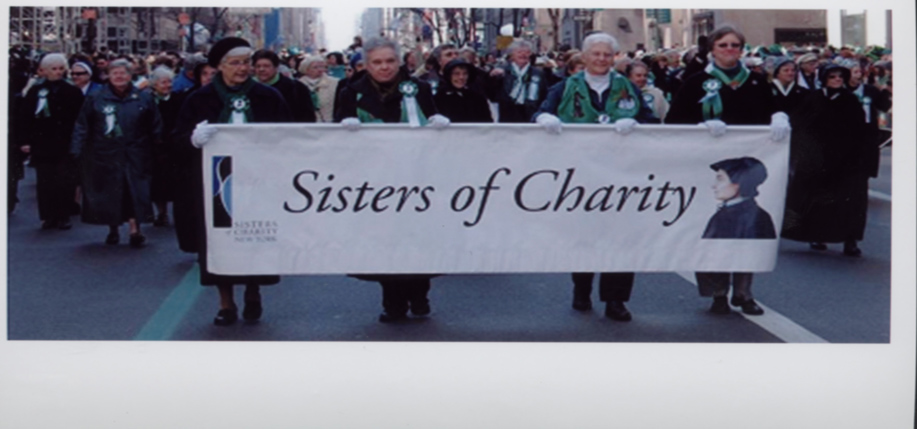St. Patrick’s Day is always an important day for the Irish in New York and the 2009 St. Patrick’s Day Parade was a very special one for the Sisters of Charity. Not only was it the first time that they marched in their own congregational contingent, but the 248th parade was dedicated to the Sisters in recognition of their “200 years of dedicated service to the Poor of New York City.”
It’s a description that encapsulates the enormous impact and profound effect that the Sisters of Charity missions have had on so many lives.
For two centuries, four thousand Sisters have served Irish and other immigrants and their descendants, caring for orphans and the elderly, teaching young people, and providing job training to the poor. Their missions have supported families, nursed the sick, educated leaders, and always nurtured the Catholic faith.
It all began in 1809 when Elizabeth Ann Seton, a New York widow and convert, founded the Sisters of Charity in Emmetsburg, Maryland. The Sisters of Charity’s mission in New York began in 1817, when Mother Seton sent three Sisters to care for orphaned immigrant children in St. Patrick’s Orphan Asylum.
Since then the Sisters of Charity have established over 286 foundations, from New York State, New Jersey, Connecticut, Rhode Island, Pennsylvania, North Carolina to the Bahamas and Guatemala.
“When planning started for the St. Patrick’s Day event,” explains Christine Haggerty, the Director of External Communications, whose idea of the Sisters marching behind their own banner was presented to the parade officials by Bill Hurley, director of development, “the goal was to find 200 willing to march behind the Sisters’ banner – one person for each year since the founding of the Sisters of Charity. On the big day, over 700 turned out!”
After joining NYC’s Mayor Michael Bloomberg for a 7:00 a.m. breakfast, Sister Dorothy Metz, President of the Congregation, and Sister Donna Dodge, her assistant, joined other Sisters at St. Patrick’s Cathedral for the 8:30 Liturgy, where Cardinal Edward Egan was the principal celebrant.
“Then it was down to 44th Street where the Sisters of Charity contingent formed to march up Fifth Avenue,” describes Christine. “The block was full of Sisters and their associates, family members and friends.” Colleagues from health and child care and housing ministries also attended.
“Our community also invited other congregations in the Sisters of Charity Federation as well as the Daughters of Charity of Albany, New York, and even some Sisters out of Leavenworth, Kansas, and Greensburg, Pennsylvania, who wanted to be part of this unique event.”
Three teams of Sisters took turns carrying the 10-foot banner, one of whom was Sister Peggy McEntee, who has been immortalized on stage and screen by the playwright and screenwriter John Patrick Shanley when he dedicated his 2005 Pulitzer Prize-winning play, Doubt: A Parable, to her. He wrote in the Playbill, “This play is dedicated to the many orders of Catholic nuns who devoted their lives to serving others in hospitals, schools and retirement homes. Though they have been much maligned and ridiculed, who among us has been so generous?”
Such words of conviction and sincerity on behalf of the Bronx-born playwright came from personal experience: Shanley had never forgotten his first-grade teacher, Sister James (now Sister Peggy), a Sister of Charity, who had strongly influenced him by her attentive kindness and generous spirit.
He not only based a character of his play on his former teacher, he also hired her to consult on the movie version of Doubt when they were filming on location at the College of Mount St. Vincent in the Bronx, one of the many institutions founded by the Sisters of Charity. Amy Adams won an Oscar nomination for her performance as Sister James.
“I loved marching in the parade,” recalls Sister Peggy, who had just returned from Hollywood where she represented John Patrick in accepting the award for Doubt as best picture from the Catholic in Media Association. “I made it to the end,” she said cheerfully. “It made me feel young.”
Three other Sisters had the honor of representing the first three Sisters of Charity who were sent by Mother Seton to New York in 1817. Wearing the traditional habit, Sisters Dominica Rocchio, Alice Darragh and Jane Iannucelli all marched in a row behind the banner, pleased to represent those pioneer Sisters Felicité Brady, Cecilia O’Conway and Rose White.
“As they passed the Cathedral, Cardinal Egan and other bishops came into Fifth Avenue to greet the Sisters,” describes Christine Haggerty. “During the day the Cardinal told Catholic New York, ‘Nothing could have made me happier than to learn that the St. Patrick’s Day Mass and Parade would honor, in a very special way, our beloved Sisters of Charity. The work they have done is nothing short of heroic, and we could never thank them enough.’”


Leave a Reply